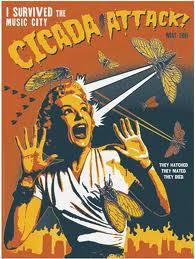
Two weeks ago outside my school I could hardly hear myself talk on the phone for the the thousands of chirruping cicadas that covered the trunks of the dozens of trees on the property. I gave up the conversation to take pictures of this particular breed of cicada called "Brood XIX" which emerges every thirteen years. Here are a few photos (Imagine the background to be the grotesquely amplified sound of a million, battery-operated, toddler toys in the past phase of its juice). Cicadas are the Goliath version of flies without the stigma of living on poop and throwing up in your sugar bowl. Below is a photo of a serene cicada. He's not mating. He's not latching himself to my head. He's not making a peep.
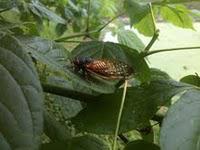
This is what we saw on every edifice in the Nashville area several weeks ago: the alien shells of cicadas (My wife and I watched a waste of film a few weeks ago called SKYLINE. It ended up being some apocalyptic flick where insects were rapturing people who didn't want to be raptured. I fell asleep towards the end which tells you how bad of a movie it must have been. Because insects are the most abundant form of life in the world, it is believed by some funny scientists that aliens, if the exist, are more likely to look like insects than humanoid).
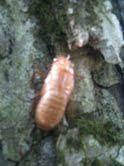
I had never seen a cicada hatch before two weeks ago. It is rather impersonal the way they come out of their shells. I don't know, imagine a caterpillar turning into a butterfly. Now imagine that caterpillar doing so many drugs in his life that when he emerges, he doesn't do so gracefully and he is void of all color.
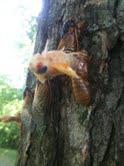
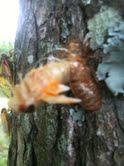
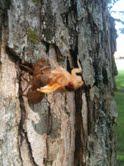
He looks a bit normal when he is done being born again.
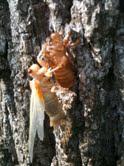
Like I said, they are colorless when finished hatching.
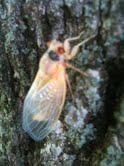
Several years ago, I caught a few who were "off season." They had eye color that ranged from blue to green. "Brood XIX" have red eyes. Someone started a rumor a few days ago that Vanderbilt University was paying $300 per blue-eyed mutant cicada. The University kept getting phone calls.
I read a few days ago that fishermen have had some really nice catches lately because drowning cicadas have brought the large fish to the surface. While being cleaned, nice-sized catches have been found to be glutted with cicadas. Even the birds won't go to sleep! They are up all night, undoubtedly, eating their fill of the creatures who average at least two inches in length, being responsible for my falling asleep at 2:00 A.M.
I have noticed the last week or so that the smaller ones are hatching (or maybe the larger ones are shrinking?). They have been the most aggressive, latching themselves onto my clothing or skin, and screaming when pulled off. Open your car door or the front door to your house and one will take the opportunity to squeeze in. A student of mine had some graduation pictures taken that were rather amazing. When they were blown up to be printed, they noticed a cicada was on his shirt, posing along with him... with those demonic, red eyes.
They don't sting. I have been told that people eat them. That doesn't surprise me, and I don't blame them. Grasshoppers, ants, and snails are edible in civilized parts of the world, so why not cicadas? While in Bavaria during the summer of 1987, I ate a snail (They called it escargo, but I saw the cook pick it off a leaf in the garden. It was a snail).
As I am sitting writing this blog right now, I am in my livingroom with the overhead fan on, with the curtains drawn, with my children playing and screaming on the trampoline, and I can STILL hear the mating calls of the promiscuous cicadas as backdrop to everything. Thirteen years from now I will be fifty-two and a little deafer, so I should be enjoying them while I can.
